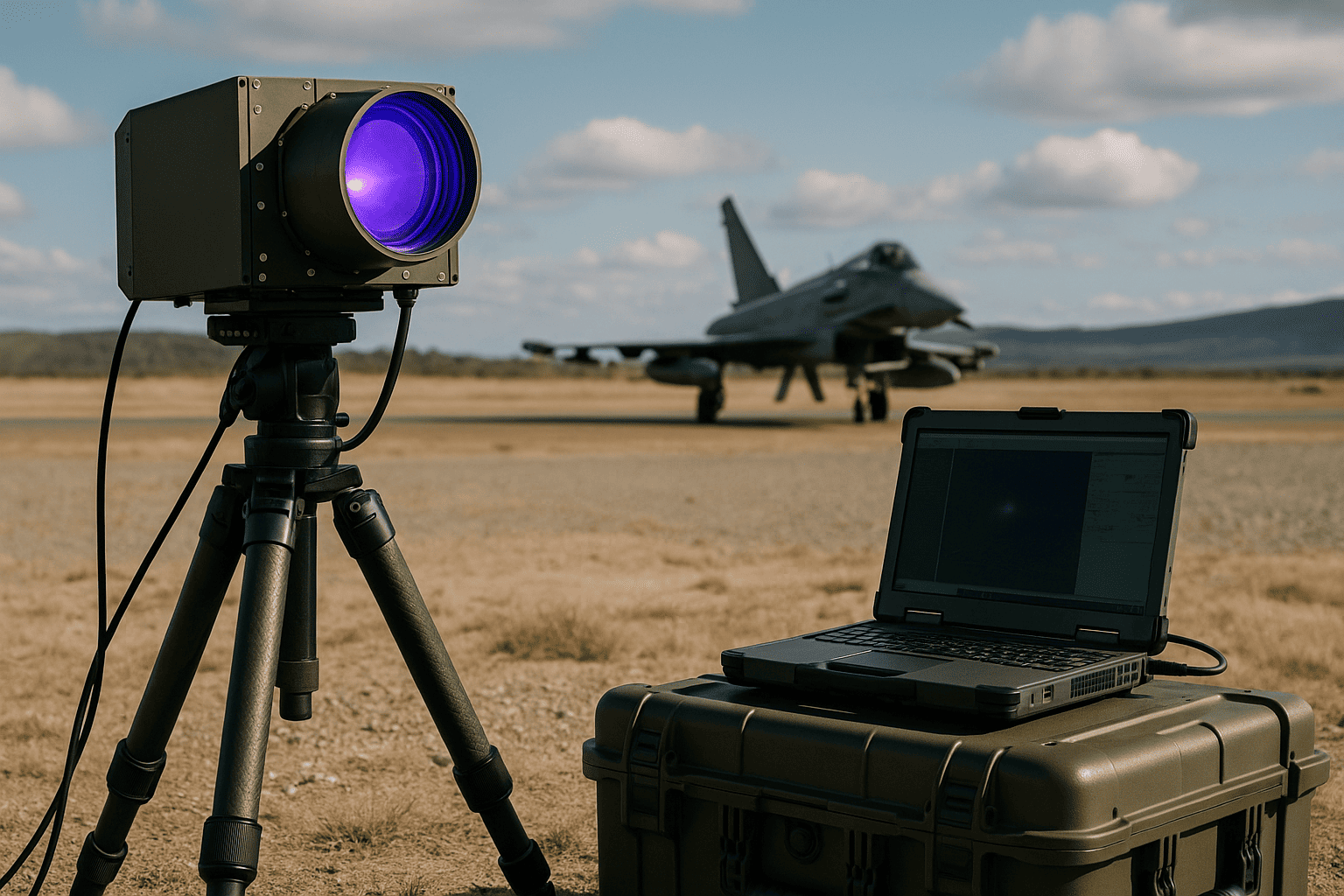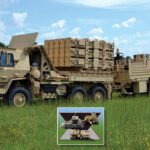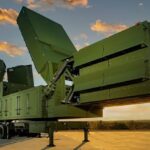Ian Will, Manager of Electro-optic EW Systems at Tenix Defence Systems, confirmed today that a foreign customer has placed an order for three Mallina long-range ultraviolet stimulators. Each unit will ship from the company’s Welshpool facility before the end of the calendar year. The deal, while modest in quantity, marks the first export sale of the Mallina series and signals growing confidence in Australian-designed threat-emulation equipment. This reflects a broader trend in defence procurement, where militaries invest in advanced low-signature radar and threat simulation systems like the Silent Knight radar to support survivability and electronic warfare training.
Ultraviolet Threat Simulation for Missile-Warning Training
The Mallina stimulator projects a tightly controlled ultraviolet plume that matches the ignition signature of a surface-to-air missile. At a test range the beam can reach aircraft sensors up to six kilometres away, allowing crews to exercise missile-warning logic without the cost or risk of live firings. Early ground trials held at RAAF Base Pearce showed reliable cueing of legacy ultraviolet missile-warning sets as well as the next-generation two-colour arrays now entering service.
Tenix engineers built the emitter around solid-state flash-lamp technology rather than pyrotechnic cartridges. The choice makes the device safer to deploy on austere ranges, reduces recurring costs, and shortens the set-up cycle to under ten minutes. A fibre-optic link feeds real-time telemetry back to the control shelter so range staff can tweak pulse repetition, rise-time and radiant intensity on the fly. The company claims the module’s sealed housing will survive twenty full deployments without maintenance in desert or maritime climates.
Export Strategy and Integration into Global Electronic Warfare Systems
The three systems on order will leave the factory with a supplemental kit that includes:
- A collapsible carbon-fibre tripod rated for 50 kg static load.
- A weatherproof power converter accepting 90-264 V AC.
- A ruggedised laptop running the Mallina Range Controller software over MIL-STD-1553 or RS-485.
All spares travel in two standard NATO-size transit cases to ease air freight.
Partnership with NATO-Aligned Defence Industry
Tenix is marketing the product in partnership with Elettronica Systems Limited of the United Kingdom. The two firms signed a teaming agreement last year to share data on atmospheric attenuation and to cross-certify safety procedures for European firing ranges. This effort aligns with Australia’s broader push to establish a sovereign electronic-warfare programming infrastructure that supports platforms like the F-35 and Growler. Elettronica brings long-standing relationships with several NATO test centres, while Tenix supplies the hardware and handles depot-level repairs in Australia.
Beyond ultraviolet, the alliance is working on laser-based and dual-colour infrared stimulators. These follow-on devices will replicate range-gated laser designators and hot-plume missile seekers, giving aircrews a full spectrum of electro-optic threats from a single control console. Engineers intend to match the Mallina user interface so range officers can script composite attacks without rewriting mission profiles.
In a separate development, the Australian and United States Defence Departments last month approved Phase 2 of Task 7 – Electro-Optic Stimulation under Project Arrangement 10. The new phase directs Tenix to deliver a laser threat simulator and to stand up support facilities for the Common Missile Warning System (CMWS) and Advanced Threat Infra-Red Countermeasure (ATIRCM) programmes. Funding also covers further work with the Centre for Electro-Optic Propagation Studies (CEOPS) at the University of Western Australia, where academics feed empirical data into Tenix’s ray-tracing model. The updated model will help schedulers predict signal loss in humid or dusty airframes and reduce aborted sorties during monsoon season.
Ian Will expects the fresh order and the Task 7 milestones to underpin “a robust business in long-range stimulation devices” over the next twelve months. The company is already talking with two U.S. prime contractors about supplying Mallina units for helicopter survivability exercises. “Air forces need a safe way to practise missile-break procedures at full stand-off range,” Will explained. “Live shots drain budgets fast, and pyrotechnic rockets bring local airspace restrictions. We give them a repeatable, instrumented alternative.”
Advanced Electro-Optic Simulation in Modern Combat Environments
Defence observers note that ultraviolet missile-warning sensors have matured rapidly since the mid-nineties. Early single-pixel detectors struggled to separate a true plume from solar reflections or battlefield fires. Parallel advances such as the integration of optical radio-frequency technologies into EW systems further illustrate the shift toward modular, cross-domain threat simulation. The latest quadrant arrays add temporal discrimination and improved self-testing, but they still need validation under complex sky conditions. A programmable stimulator lets evaluators layer cloud scatter, flare wash and background clutter in precise order, exposing corner cases that might otherwise slip through factory inspection.
For Tenix, the export contract also highlights the growing depth of Australia’s defence-electronic supply chain. This mirrors Australia’s growing role in electronic warfare exports, as the country expands its contribution to global EW systems. The company sources emitter sub-assemblies from local optics specialists, while the power electronics draw on a Perth plant opened in 1999. The arrangement keeps intellectual property at home and shortens lead-times for mid-life updates.
Domestic demand should follow. The Royal Australian Air Force’s AIR 5416 Phase 3 upgrade calls for a new missile-warning suite on F-111C strike aircraft, with flight testing scheduled for late 2002. Defence planners want a home-grown stimulator on hand so instrumented sorties can proceed soon after installation. Tenix insiders hint that a letter of intent may appear once the export units demonstrate reliability in country.
Looking ahead, management is weighing a cooled-detector option that would let the Mallina pulse at a higher duty cycle. The tweak could bring stand-off range to eight kilometres without raising platform temperature past safe limits. Another study is examining an adapter ring for shipboard mounting, enabling test teams to challenge maritime patrol aircraft from a moving deck.
With three units sold and further interest brewing, Tenix believes the Mallina line will anchor its electro-optics division for the rest of the decade. The firm’s stated goal is to capture at least twenty-five percent of the global market for missile-warning stimulators by 2005. That figure may sound ambitious, but the defence-sector appetite for realistic, low-risk training looks set to expand as cockpit automation tightens reaction windows and raises the cost of unexpected false alarms. (ends)
Mallina’s Evolution in Electronic Warfare Systems – March 2025 Update
A quarter-century of operational use confirms that first assumption. The original three stimulators logged more than 3 500 range sorties and survived two full rebuilds. In 2008 Tenix Defence became part of BAE Systems Australia, folding the Mallina programme into a larger electronic-warfare portfolio.
Commercial rights changed hands again in 2013 when Textron Systems acquired the U.K. partner and re-launched the product family under its Hunt Valley electronics branch. The present Mallina-180 LED variant pushes effective range to ten kilometres, halves power draw, and weighs forty percent less than the flash-lamp unit delivered back in 2001.
Textron engineers replaced legacy xenon flash-lamps with narrow-band UV LEDs. The solid-state source gives a cleaner rise-time and allows micro-waveform modulation that mirrors solid-fuel burn fluctuations seen in real rocket motors. Field technicians swap emitter boards in minutes, a task that once demanded a climate-controlled workshop.
U.S. ranges adopted the upgrade early. The Department of Defense’s Center for Countermeasures lists the “Ultraviolet Mallina Stimulator” as standard instrumentation for MANPADS evaluation and for F-35 block upgrade trials. The stimulator now pairs with the High-Power Portable Range Threat Simulator so crews can face a coordinated RF and UV attack in one pass.
Europe followed. The U.K. Defence Science and Technology Laboratory integrated four Mallina-180 sets into the Hebrides range in 2022, tying them to the Long-Range Radar Annex so RAF crews receive automated kill-chain playback within thirty seconds of each run. Poland’s 41st Air Base Command ordered two more units in 2024 for Mi-24 upgrade tests, citing the cleaner UV spectrum and the battery-power option for remote forest clearings.
Recent software drops add a terrain-aware script engine. Range officers can import digital-elevation models, place the emitter on virtual slopes, and preview sensor line-of-sight before a sortie brief. The module also streams telemetry over encrypted Wi-Fi, removing cable runs that once tripped ground crews.
Global Adoption of Modular UV Simulators in Defence Training
Key customers today are:
- United States Air Force and Army test centres
- Royal Air Force Air and Space Warfare Centre
- Royal Australian Air Force Aircraft Research & Development Unit
- Japan Air Self-Defense Force Electronic Warfare Squadron
- NATO Centre of Excellence for Counter-IED and Energy Security
Each operator writes bespoke threat scripts, but data collected over a decade show a common trend: ultraviolet channels remain the first line of cueing for missile-approach logic even in tri-mode sensors. Mallina gives evaluators a way to stress that channel without risking white-hot rocket debris on an active range.
Research continues. The University of Western Australia’s CEOPS now models oceanic haze scatter for Textron’s planned shipboard Mallina Maritime. Early bench trials hint at a 30 % boost in on-target irradiance for deck-level launch angles. First live shots are pencilled in for Q4 2025 aboard HMAS Stuart.
Financially, the programme moved from hand-built prototypes to small-batch serial production in 2020 when Textron opened a dedicated line in Maryland. Throughput sits at twenty-five units a year with surge capacity to thirty-five. Demand shows no sign of tapering as more nations bolt missile-warning sensors onto rotary-wing fleets that were once blind to shoulder-launched threats.
Looking forward, engineers are prototyping Mallina-Lite, a rucksack version intended for rapid-set ranges inside humanitarian corridors. If funding holds, Textron expects limited-rate initial production in 2027.
The story that started with three units on order in 2001 has grown into a global standard for ultraviolet threat emulation. The technology matured, company logos changed, but the core requirement remained: train crews against a credible, repeatable, and safe surrogate for a hostile missile. Mallina continues to meet that need.
REFERENCE SOURCES
- https://www.dvidshub.net/news/94683/range-division-clears-way-exercises
- https://www.aph.gov.au/parliamentary_business/committees/house_of_representatives_committees?url=scin/pathways/subs/sub83.pdf
- https://www.emerald.com/insight/content/doi/10.1108/aeat.2002.12774baf.004/full/html
- https://www.australiandefence.com.au/FBE7FD40-F806-11DD-8DFE0050568C22C9
- https://www.textronsystems.com/products/mallina
- https://www.textronsystems.com/sites/default/files/_documents/TS_ES_Mallina_datasheet%20(1).pdf
- https://www.dote.osd.mil/About/Organization/CCM/Warfighter-Training/



